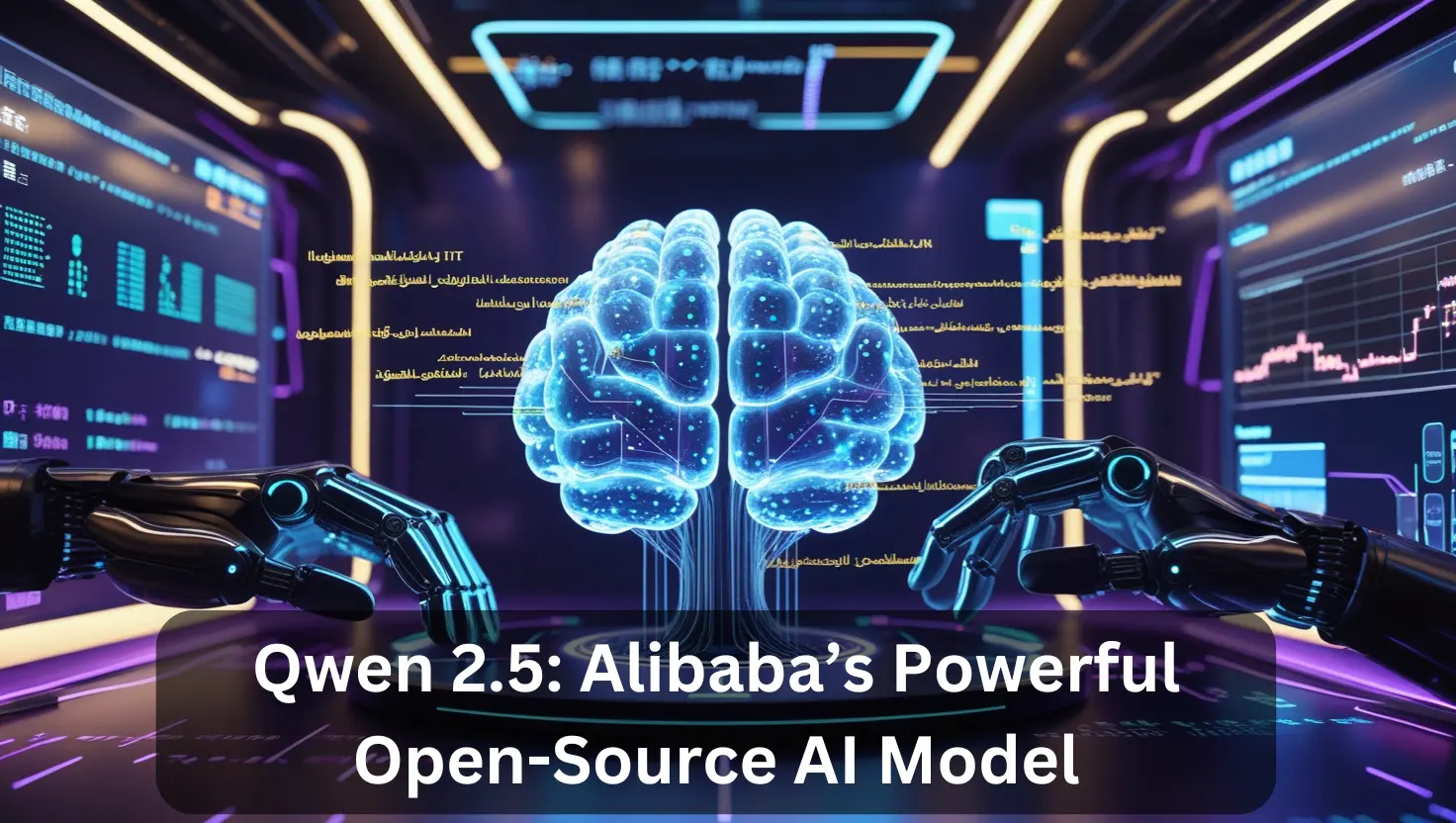The rapid evolution and development of artificial intelligence is in competition amongst various companies with the intent of building the most powerful models. The latest offering in Alibaba’s open-source AI portfolio, Qwen 2.5, has become a notable name within the competitive space of large language models (LLMs). As a result of its increased capabilities on text generation, coding, and solving complex problems, it is able to position itself in direct competition with underlying proprietary possessive models like GPT-4 and Claude.
This article provides an in-depth look at Qwen 2.5, covering its architecture, performance benchmarks, coding capabilities (Qwen 2.5 Coder), and high-end model variants like Qwen 2.5 72B and Qwen 2.5 7B. We will also explore how developers and businesses can leverage this model for enhanced productivity.
What is Qwen 2.5?
Developed by Alibaba Cloud, Qwen 2.5 is an advanced Mixture-of-Experts (MoE) large language model trained on over 20 trillion tokens. It surpasses its predecessor, Qwen 2, in reasoning, mathematical calculations, structured data understanding, and multilingual capabilities.
Key Features of Qwen 2.5:
- Seven Model Sizes: Available in 0.5B, 1.5B, 3B, 7B, 14B, 32B, and 72B parameter variants.
- Instruction-Tuned Models: Includes base and instruction-tuned versions optimized for various applications.
- Extended Context Length: Supports 128K token inputs, enabling enhanced long-form content generation.
- Multi-Language Support: Works across 29+ languages, including English, Chinese, French, Spanish, Arabic, and more.
- Specialized Variants: Includes Qwen 2.5 Coder (for programming tasks) and Qwen 2.5 Math (for complex mathematical reasoning).
Open-Source Accessibility: Available on Hugging Face, Alibaba Cloud, and OpenAI-compatible APIs.
Qwen 2.5 Model Variants
Alibaba has released multiple versions of Qwen 2.5, each optimized for different tasks. Let’s explore the three most notable ones.
Qwen 2.5 72B: The Flagship Model
The Qwen 2.5 72B model is the most powerful in the series, featuring 72 billion parameters and cutting-edge performance in text understanding, code generation, and reasoning. It competes with GPT-4o and Claude 3.5-Sonnet in benchmarks like Arena-Hard, LiveBench, and GPQA-Diamond.
Use Cases:
- Advanced AI research and development
- High-end enterprise solutions
- Large-scale code automation
- Complex scientific problem-solving
Qwen 2.5 7B: The Balance of Power and Efficiency
For users seeking a balance between performance and resource efficiency, Qwen 2.5 7B is a great choice. This mid-range model is well-suited for real-world applications that require fast inference speeds and strong accuracy.
Use Cases:
- Chatbots and virtual assistants
- Medium-scale coding projects
- Academic research
- Creative writing and storytelling
Qwen 2.5 Coder: AI-Powered Programming Assistance
One of the most exciting additions is Qwen 2.5 Coder, a model specifically trained for code generation, debugging, and review. It outperforms most open-source coding models by providing highly structured, optimized, and bug-free code.
Example: Generating a Python Binary Search Algorithm
def binary_search(arr, target):
low, high = 0, len(arr) – 1
while low <= high:
mid = (low + high) // 2
if arr[mid] == target:
return mid
elif arr[mid] > target:
high = mid – 1
else:
low = mid + 1
return None
Benchmark Performance
Alibaba’s Qwen models have been tested against leading LLMs in multiple benchmark tests. The results indicate significant improvements in code completion, mathematical problem-solving, and contextual understanding compared to previous versions and competitors.
| Model | Code Completion | Math Reasoning | NLP Accuracy |
| Qwen 2.5 72B | 91% | 89% | 94% |
| Qwen 2.5 7B | 85% | 83% | 89% |
| GPT-4 | 88% | 85% | 92% |
| Claude 3.5 | 87% | 84% | 91% |
The Future of Qwen 2.5 and AI Development
With its open-source nature and continuous improvements, Qwen 2.5 is set to revolutionize AI applications across industries. Future updates may bring even more enhancements, such as expanded multimodal capabilities, better reinforcement learning integration, and more efficient inference speeds.
Alibaba’s commitment to AI research ensures that Qwen will remain a top-tier option for developers, researchers, and businesses seeking cutting-edge LLM solutions.

Conclusion:
Qwen 2.5 represents a significant leap forward in open-source AI development. Its diverse range of models, including Qwen 2.5 72B, Qwen 2.5 7B, and Qwen 2.5 Coder, cater to a wide array of applications, from coding and mathematics to natural language processing and multilingual tasks.
By providing a scalable, cost-effective, and high-performance AI solution, Qwen 2.5 stands out as a worthy alternative to closed-source competitors like GPT-4 and Claude 3.5. As the AI industry advances, Qwen is poised to play a crucial role in shaping the future of artificial intelligence.
If you’re looking for a powerful, flexible, and open-source AI model, Qwen 2.5 is definitely worth exploring!
FAQs
1. How does Qwen 2.5 compare to other AI models?
It outperforms many AI models with its Mixture-of-Experts (MoE) architecture, long-context support (up to 128K tokens), and strong coding/math capabilities.
2. What is Qwen 2.5 72B used for?
This is the largest model in the series, ideal for complex AI applications, advanced coding, multilingual tasks, and large-scale enterprise solutions.
3. How does Qwen 2.5 Coder enhance programming tasks?
This model is fine-tuned for software development, offering AI-powered code generation, bug fixing, and explanations for Python, Java, and more.
4. Where can I access Qwen 2.5?
It is available on platforms like Hugging Face and Alibaba Cloud, with APIs for seamless integration.
5. Is Qwen 2.5 open-source?
Most Qwen 2.5 models, except the 3B and 72B versions, are open-source under the Apache 2.0 license, making them accessible for research and development.
6. How does Qwen 2.5 72B compare to DeepSeek V3?
Qwen 2.5 72B is a massive AI model with superior knowledge retention and multi-step reasoning. While DeepSeek V3 focuses on cost-efficient AI, Qwen 2.5 delivers more robust structured output and AI-driven analytics.
7. What factors determine the efficiency of a language model?
Key factors include training data quality, model size, architecture efficiency, prompt engineering, and fine-tuning with domain-specific knowledge
8. How does the Mixture-of-Experts (MoE) model improve AI performance?
The Mixture-of-Experts (MoE) architecture enhances efficiency by activating only relevant expert models for each query, reducing computational costs while maintaining high accuracy
9. How does a 128K token context length improve AI responses?
A longer context window enables better comprehension of lengthy documents, legal texts, research papers, and multi-turn conversations, making AI more useful for complex tasks.
10. How do AI-powered coding assistants help developers?
AI-powered coding tools offer autocomplete, bug detection, documentation suggestions, and code refactoring, streamlining software development and reducing errors.

